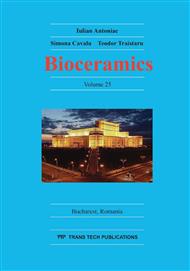[1]
S.B. Bhaduri, S. Bhaduri, Biomaterials for Dental Applications, in: R. Narayan (Ed. ), Biomedical Materials, Springer, 2009, pp.295-326.
DOI: 10.1007/978-0-387-84872-3_11
Google Scholar
[2]
R. van Noort, Introduction to dental materials, third ed. Elsevier, Philadelphia, (2007).
Google Scholar
[3]
M. Weinstein, S. Katz and A.B. Weinstein, U.S. Patent 3, 052, 982 (1962).
Google Scholar
[4]
M. Weinstein and A.B. Weinstein, U.S. Patent 3, 052, 983 (1962).
Google Scholar
[5]
T. Korkmaz, V. Asar, Comparative evaluation of bond strength of various metal–ceramic restorations, Materials and Design 30 (2009) 445–451.
DOI: 10.1016/j.matdes.2008.06.002
Google Scholar
[6]
M.J. Reyes, Y. Oshida, C.J. Andres, T. Barco, S. Hovijitra, D. Brown, Titanium–porcelain system, Part III: Effects of surface modification on bond strengths, Biomed Mater Eng 11 (2001) 117–36.
Google Scholar
[7]
M.W. Finnis, The theory of metal–ceramic interfaces, J. Phys.: Condens. Matter 8 (1996) 5811–5836.
DOI: 10.1088/0953-8984/8/32/003
Google Scholar
[8]
M. Chakmakchi, G. Eliades, S. Zinelis, Bonding agents of low fusing cpTi porcelains: Elemental and morphological characterization, Journal of Prosthodontic Research 53 (2009) 166–171.
DOI: 10.1016/j.jpor.2009.03.003
Google Scholar
[9]
G.W. Ho, J.P. Matinlinna, Insights on Ceramics as Dental Materials. Part I: Ceramic Material Types in Dentistry, Silicon 3 (2011) 109–115.
DOI: 10.1007/s12633-011-9078-7
Google Scholar
[10]
A. Wang, C. Ge, H. Yin, Y. Gao, T. Jiang, C. Xia, G. Wu, Z. Wu, Evolution of silica coating layer on titanium surface and the effect on the bond strength between titanium and porcelain, Applied Surface Science 276 (2013) 723-730.
DOI: 10.1016/j.apsusc.2013.03.160
Google Scholar
[11]
I. Ozacan, H. Uysal, Effects of silicon coating on bond strength of two different titanium ceramic to titanium, Dental Materials 21 (2005) 773-779.
DOI: 10.1016/j.dental.2005.01.014
Google Scholar
[12]
Metal ceramic dental restorative systems, BS EN ISO 9693: (2000).
Google Scholar
[13]
R.N. Wenzel, Resistance of solid surfaces to wetting by water, Ind. Eng. Chem. 28 (1936) 988–994.
DOI: 10.1021/ie50320a024
Google Scholar
[14]
G.D. Woolsey, L. Lorton, W.J. O'Brien, The Wetting of Ceramic Opaque Suspensions on Oxidized Alloy Surfaces: Phase II, U.S. Army Institute of Dental Research, (1984).
Google Scholar
[15]
T.Y. Han, J.F. Shr, C.F. Wu, C.T. Hsieh, A modified Wenzel model for hydrophobic behavior of nanostructured surfaces, Thin Solid Films 515 (2007) 4666–4669.
DOI: 10.1016/j.tsf.2006.11.008
Google Scholar
[16]
C. W. Yao, T. P. Garvin, J. L. Alvarado, A. M. Jacobi, B. G. Jones, C. P. Marsh, Droplet contact angle behavior on a hybrid surface with hydrophobic and hydrophilic properties, Appl. Phys. Lett 101 (2012) 111605.
DOI: 10.1063/1.4752470
Google Scholar
[17]
G. Palasantzas, J. Th.M. de Hosson, Wetting on rough surfaces, Acta Materialia 49 (2001) 3533–3538.
DOI: 10.1016/s1359-6454(01)00238-5
Google Scholar
[18]
R. Baboian, Corrosion tests and standards: application and interpretation, ASTM Series, Philadelphia, USA, (2005).
Google Scholar
[19]
F. Mansfeld, The polarization resistance technique for measuring corrosion currents, in: M.G. Fontana, R.H. Staehle (Eds. ), Advances in Corrosion Engineering and Technology, Plenum Press 7, New York, 1976, pp.163-262.
DOI: 10.1007/978-1-4684-8986-6_3
Google Scholar
[20]
V. Poulek, J. Musil, R. Cerny, R. Jr. Kusel, ε-Ti2N phase growth control in titanium nitride films, Thin Solid Films 170 (1989) L55-L58.
DOI: 10.1016/0040-6090(89)90738-4
Google Scholar
[21]
K.S. Fancey, C.A. Porter, A. Matthews, Relative importance of bombardment energy and intensity in ion plating, J. Vac. Sci. Technol. A13 (1995) 428-435.
DOI: 10.1116/1.579375
Google Scholar
[22]
E. Kelesoglu, C. Mitterer, M. Ürgen, Corrosion characteristics of plain carbon steel coated with TiN and ZrN under high-flux ion bombardment Surf. Coat. Technol. 160 (2002) 82-86.
DOI: 10.1016/s0257-8972(02)00358-4
Google Scholar
[23]
H. Zhang, T.W. Guo, Z.X. Song, X.J. Wang, K.W. Xu, The effect of ZrSiN diffusion barrier on the bonding strength of titanium porcelain, Surf. Coat. Technol. 201 (2007) 5637–5640.
DOI: 10.1016/j.surfcoat.2006.07.023
Google Scholar


